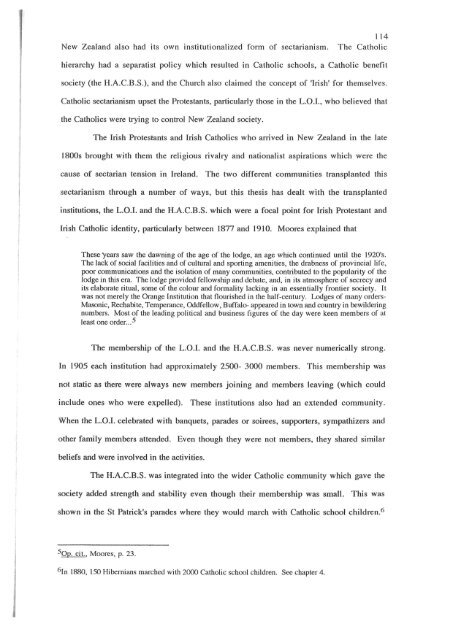TRANSPLANTED IRISH INSTITUTIONS - University of Canterbury
TRANSPLANTED IRISH INSTITUTIONS - University of Canterbury
TRANSPLANTED IRISH INSTITUTIONS - University of Canterbury
Create successful ePaper yourself
Turn your PDF publications into a flip-book with our unique Google optimized e-Paper software.
New Zealand also had its own institutionalized form <strong>of</strong> sectarianism.<br />
114<br />
The Catholic<br />
hierarchy had a separatist policy which resulted in Catholic schools, a Catholic benefit<br />
society (the H.A.C.B.S.), and the Church also claimed the concept <strong>of</strong> 'Irish' for themselves.<br />
Catholic sectarianism upset the Protestants, particularly those in the L.O.I., who believed that<br />
the Catholics were trying to control New Zealand society.<br />
The Irish Protestants and Irish Catholics who arrived in New Zealand in the late<br />
1800s brought with them the religious rivalry and nationalist aspirations which were the<br />
cause <strong>of</strong> sectarian tension in Ireland. The two different communities transplanted this<br />
sectarianism through a number <strong>of</strong> ways, but this thesis has dealt with the transplanted<br />
institutions, the L.O.I. and the H.A.C.B.S. which were a focal point for Irish Protestant and<br />
Irish Catholic identity, particularly between 1877 and 1910. Moores explained that<br />
These 'years saw tbe dawning <strong>of</strong> the age <strong>of</strong> the lodge, an age which continued until the 1920's.<br />
The lack <strong>of</strong> social facilities and <strong>of</strong> cultural and sporting amenities, the drabness <strong>of</strong> provincial life,<br />
poor communications and the isolation <strong>of</strong> many communities, contributed to the popularity <strong>of</strong> the<br />
lodge in this era. The lodge provided fellowship and debate, and, in its atmosphere <strong>of</strong> secrecy and<br />
its elaborate ritual, some <strong>of</strong> the colour and formality lacking in an essentially frontier society. It<br />
was not merely the Orange Institution that nourished in the half-century. Lodges <strong>of</strong> many orders<br />
Masonic, Rechabite, Temperance, Oddfellow, Buffalo- appeared in town and country in bewildering<br />
numbers. Most <strong>of</strong> the leading political and business figures <strong>of</strong> the day were keen members <strong>of</strong> at<br />
least one order .. . 5<br />
The membership <strong>of</strong> the L.O.I. and the H.A.C.B.S. was never numerically strong.·<br />
In 1905 each institution had approximately 2500- 3000 members. This membership was<br />
not static as there were always new members joining and members leaving (which could<br />
include ones who were expelled). These institutions also had an extended community.<br />
When the L.O.I. celebrated with banquets, parades or soirees, supporters, sympathizers and<br />
other family members attended. Even though they were not members, they shared similar<br />
beliefs and were involved in the activities.<br />
The H.A.C.B.S. was integrated into the wider Catholic community which gave the<br />
society added strength and stability even though their membership was small. This was<br />
shown in the St Patrick's parades where they would march with Catholic school children. 6<br />
SOp. cit., Moores, p. 23.<br />
6In 1880, 150 Hibernians marched with 2000 Catholic school children. See chapter 4.
















